Largest tethered blimps ever used in the U.S. military operations in Afghanistan |
| wokipi aerostation | ||
Today U.S. troops in Iraq and Afghanistan use aerostats for force protection with an Army program called the Rapid Aerostat Initial Development (RAID). Since its initial deployment in Afghanistan in 2003, over 300 RAID towers and over 60 'blimp' systems have been deployed as part of the Persistent Surveillance and |
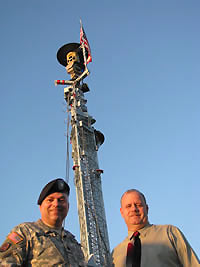 |
Dissemination Systems, safeguarding forward operating bases, improving surveillance in day and night. Raytheon Company, leader in developing defense technologies, is the prime contractor for the program, which uses a 55-foot (17-meter) TCOM-built aerostat that floats 984 feet (300 meters) high to perform surveillance with an electro-optical infrared sensor (with a total weight of 200 pounds). |
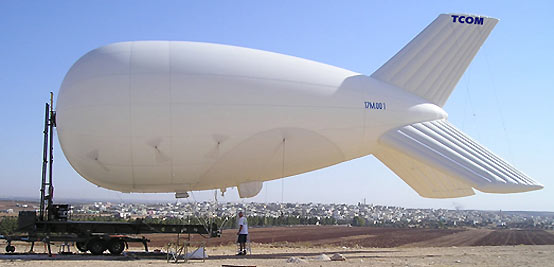 |
300th RAID Tower |
aerostat 17M - TCOM |
supporting such forces with live streaming video being broadcast on the military intranet. Such service provides quick-reaction forces on the operational area. Streaming video is automatically compressed to fit the capacity of each user's communication links. Different systems can share information and images with each other. |
July 2009: Canada is spending $23 million to buy towers and aerostats, both equipped with cameras and radars. These will be used for base defense, and surveillance in general in Afghanistan. The Canadians have noted the success of the U.S. forces with this kind of intelligence collection and base security system. |
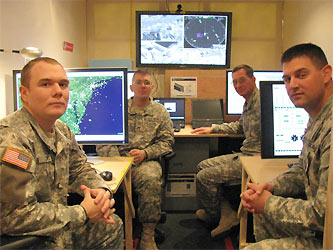 |
Today, the army is confronted with another problem: Unlike ballistic missiles that typically fly a stable and predictable flight pattern, cruise missiles pose a particularly tough challenge because of their ability to fly low and slow and change directions. The Air Force flies radar-equipped airplanes that can track cruise missiles from above, but these systems require a lot of manpower and other resources to operate. This led the Army to begin looking at the potential for radar-equipped aerostats - tethered balloons resembling blimps - to detect and track terrain-hugging cruise missiles. After a series of demonstrations to prove the concept, the Army launched a program called JLENS : Joint Land |
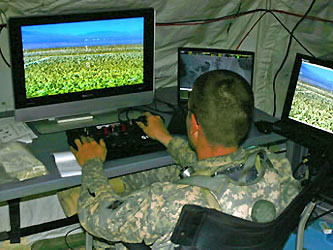 |
Attack Cruise Missile Defense Elevated Netted Sensor System with the award of a $1.4 billion development contract to Raytheon Integrated Defense Systems of Tewksbury. Picture above : March 2008 - Soldiers from Fort Bliss, Texas, try the prototype communication and control station for the JLENS. |
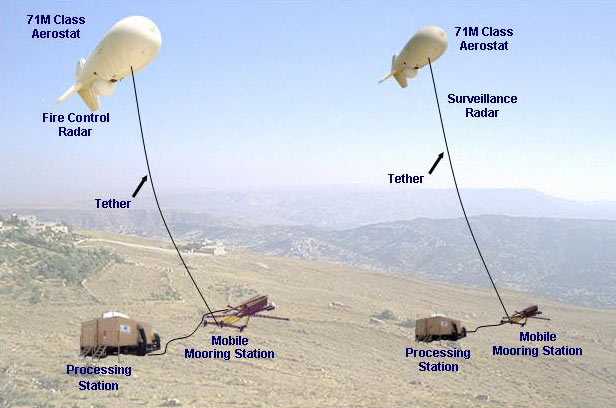 |
The JLENS (Joint Land Attack Cruise Missile Defense Elevated Netted Sensor System) will enhance surveillance capability and provide air defenders with improved ability to observe, assess, and support engagements over the entire air battlespace. So, the JLENS will be an airborne radar platform. This system also acquires and tracks surface moving targets and supports detection and trajectory prediction of tactical ballistic missiles. Raytheon is working to deliver two JLENS systems, each consisting of two 242-foot (74-meter) long helium-filled aerostats, one containing a Surveillance Radar (SuR) and one containing a Precision Target Illumination Radar (PTIR), mobile mooring stations and communications packages. The aerostats will operate nearly 2 miles (3 km) above the ground on tethers, providing the ability to detect and track cruise missiles as far as 124 miles (200 km) away in every direction. The systems are designed to operate continuously for 30 days, come down for eight hours of maintenance and go back up for another 30 days. Despite its size, the JLENS aerostat will not be easy to target because its lack of relative motion makes it tough for radars to discriminate. |
Because the aerostats are not highly pressurized, bullets won’t burst them. Its presence in the battle space allows reallocation of costly manned aircraft to support other critical missions. First aerostats are non-developmental 71-meter, tethered, non-rigid aerodynamic structures filled with helium and air. Each aerostat is tethered to a mobile mooring station and attached to a processing station through a fiber optic powered tether. The SuR provides the initial target detection, cueing the PTIR, which generates an engagement quality track. |
The helium inflation of the world's first 74 meter aerostat, manufacturing by TCOM, and flight test facilities took place in Elizabeth City, N.C. TCOM is a subcontractor to Raytheon's Integrated Defense Systems Division. The JLENS aerostat is the first of its size and is the largest aerostat to be built. It anchored to the ground by a tether and connected to an 180,000 pound mobile mooring station, covers almost the length and width of a football field. It will be able to fly a 7,000 pound communications and radar payload up to 10,000 feet. In December 2009, the aerostat will be transported to the Army's Dugway Proving Ground, Utah, to be mated with its surveillance radar. The second aerostat and its fire control radar will be mated at Dugway next May (2010), and the two platforms will be integrated as a system - or orbit - and begin limited testing in September 2010 We do not have the characteristics of the 74M (model for the army) but those of the 71M are rather similar : The 71M® aerostat is the world's most modern and reliable aerostat incorporating decades of technological advancements and refinements (before 74M). It is the largest of TCOM aerostats providing unsurpassed performance at 15,000 feet and higher. With an overall length of 71 meters and a hull volume of 16,000 cubic meters the 71M® provides maximum payload capacity of 3,500 lbs, highest operational altitude and longest continuous on-station time. The 71M® easily accommodates today's high-power, long-range radars that provide continuous detection of surface targets and low flying aircraft out to 200 nautical miles. |
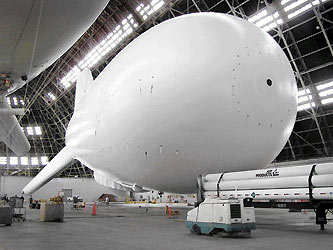 |
The 74-meter aerostat at TCOM's manufacturing |
The complete program of 18 JLENS systems consists of the purchase of 18 PTIR, 18 SuR, 36 Mobile Mooring Systems, and 36 processing systems. |
TCOM evolved in the 1960s and early 1970s to develop prototype radar and communications systems mounted in government owned World War II barrage balloons. Procured from Great Britain, these balloons were too unstable to operate satisfactorily as airborne platforms for the intended applications. Consequently, a new aerostat family was designed, constructed and tested by « Defense Advanced Research Projects Agency », NASA and other agencies of the U.S. Government. |
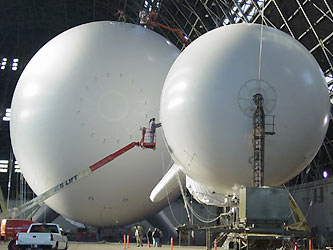 |
TCOM has pioneered all of the most significant advancements in tethered aerostat systems offering the best of today’s leading edge technology to meet the full range of your surveillance and communication needs. TCOM's Manufacturing & Flight Test Facility is located near Elizabeth City, North Carolina. This company is devoted to the design, fabrication, installation, assembly, flight test and training to aerostat and airship. For over 35 years, TCOM has installed and operated aerostat systems around the globe : in arctic, tropical and desert environments as well as in mountainous terrain. |
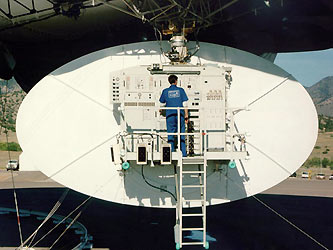 |
Aerostat Servicing at TCOM's manufacturing |
71M® Aerostat / AEW Radar |
Its facility's most prominent feature is an enormous all-weather metal hangar flanked by a paved flight operations area. At a length of 300 meters, the hangar can accommodate six fully inflated 71M® aerostats. The 500-ton clamshell doors allow ingress and egress of vehicles up to 150 feet in height. Current production types are the 17M, 32M, 38M and 71M. A new 74M system was under contract for delivery in 2009. . |
| sources et pictures credit : globalsecurity - Raytheon - TCOM - Army.Mil - Defense Update - |